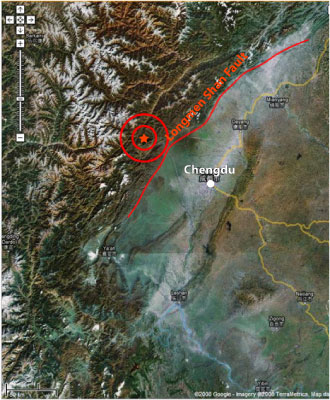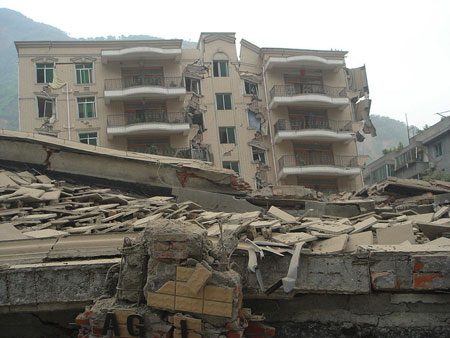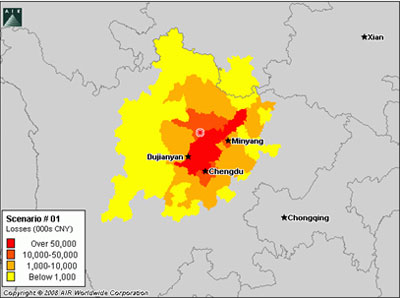
The Wenchuan Earthquake
Jun 11, 2008
June 11, 2008
Editor's Note: The magnitude 8.0 earthquake that occurred in China's Sichuan province last month was a humanitarian disaster. It will also undoubtedly become a defining event for China's burgeoning insurance market, reinforcing the need for the adoption of catastrophe of risk management best practices in a country susceptible to a multitude of perils. Within 24 hours of the earthquake, AIR issued industry loss estimates and was assisting clients assess losses to their own portfolios. In this article, Project Manager for China Dr. Bingming Shen-tu and Project Manager Dr. Tao Lai provide an overview of the May 12th Wenchuan earthquake.
The strongest—and deadliest—earthquake to strike China in more than three decades occurred in Sichuan province on May 12th at 2:28 p.m. local time. The China Earthquake Administration has estimated the magnitude at 8.01 and focal depth at 10km. The epicenter was located in Wenchuan county about 90km west northwest of Chengdu, the provincial capital and home to 11 million people. The quake lasted about two minutes and was felt as far away as Vietnam, Thailand and Russia. In China, high-rise buildings in Beijing and Shanghai—some 1,500km from the epicenter—swayed.
Still the ground has not stopped shaking as aftershocks continue to jolt the region2. The largest of these occurred on May 25, two weeks after the initial quake. The shock destroyed or damaged tens of thousands of buildings that had been compromised by the mainshock. The continued aftershocks have also caused landslides that have disrupted river flows, creating "barrier lakes" that now threaten to burst their banks. Officials particularly concerned about one barrier lake in the highlands of Sichuan Province at Tangjiashan finally received some good news on June 10 when the military, using explosives, successfully diverted water from the lake into the quake-damaged town of Beichuan. Residents had been evacuated beforehand.
The Tectonics
The May 12th Wenchuan earthquake occurred on the Longmen Shan fault in the North-South Seismic Belt of Central China, the most seismically active area in the country. The Longmen Shan fault itself is located along the eastern margin of the Tibetan Plateau. Many active faults are here, but while the majority of these are strike slip faults that are very active (moving at up to 10 mm/yr), the Longmen Shan fault displays primarily dip slip (reverse) movement, and its current slip rate is uncertain; some researchers suggest that it moves less than 1 mm/yr. Compared to other active faults along the plateau margin, this slip rate is relatively low.

Despite the length (300km) of the Longmen Shan fault zone, there have been no earthquake events exceeding M7 along this span in the past 500 years. The most recent large quake was an M6.2 event recorded in 1958, but most of the large historic quakes in this region occurred either in the north (in the western Qinling fault zone), or in the south, along the more famous Xianshuihe-Xiaojian fault system. The closest large earthquake to the Longmen Shan fault zone in recent years was the 1933 Diexi earthquake, which occurred along the Minjiang fault—about 100 km to the west. That quake destroyed the town of Diexi, caused many landslides, and killed about 9,000 people.
Because of this relative dearth of historical activity, some scientists had recently argued that this fault—which figures prominently in the AIR China Earthquake Model—is no longer taking up the major tectonic motion between the Tibet Plateau and eastern China. The occurrence of this event will undoubtedly change opinions.
The Aftermath
Several factors exacerbated the severity of the earthquake, including the shallowness of the hypocenter and the density of the population in the Sichuan region. With dense population comes dense construction. Apart from recently engineered structures in Chengdu, which withstood the earthquake fairly well, many buildings in the province toppled completely. As many as eight schools collapsed. Factories and hospitals were reduced to rubble, and five million people lost their homes. The official death toll rose precipitously in the days following the event and currently stands at nearly 70,000. About 17,000 people are still missing today.

Some new buildings did survive the earthquake, suggesting that the current building code might be appropriate if rigorously enforced. However, the collapse of so many recently engineered buildings, including schools and hospitals, suggests that either construction quality was inferior or the codes were not enforced3.
Buildings in Sichuan may have escaped adherence to codes for a variety of reasons. First, many older buildings predate the first really stringent nationwide code, which was enacted in 1978 in response to the 1976 Tangshan earthquake that killed an estimated 240,000. Except for key structures such as power plants, few of these older buildings have undergone retrofit. Interestingly, however, some older residential buildings actually performed better than newer ones. The older buildings tended to be smaller and comprised of more and thicker walls per area, while the trend is for newer buildings to have larger rooms and fewer walls, increasing building vulnerability.
Also, seismic design and construction quality are typically enforced only for engineered structures built by relatively large construction companies. Many recently built single-family buildings—struggling with costs and limited resources—were not seismically designed and constructed under professional supervision. Third, seismic provision for public buildings such as schools and hospitals is not clearly regulated for higher seismic criteria, leaving local practitioners free to interpret the code based on budget and other constraints. In the aftermath of this event, Chinese building code regulators have recognized this loophole and have requested clarification in future revisions.
For people who lost their homes, mortgage payments are an immediate concern. In principle, residents are still liable for their mortgage payments, but—during this period of disaster relief—the China Banking Regulatory Commission has ruled that banks cannot enforce mortgage payment. The banks, observers believe, will eventually have to write off these mortgages as bad debt, prompting speculation about what would happen if a similar-sized earthquake were to occur in Beijing—another seismically active region in China—where property values are even higher.
Despite enormous economic losses, China's insurance companies are largely intact because insurance take-up rates in the affected region are below the national average, particularly for residential properties. (Earthquake insurance is excluded from most standard residential policies.) Commercial take-up rates are higher, but only marginally so. And although earthquake coverage is mandatory for policies covering construction projects (the CAR/EAR line of business), smaller projects often do not purchase insurance.
Nonetheless, this event—the first earthquake to hit a metropolitan region since 1976—is likely to become a defining one for the still fledgling, but rapidly growing, insurance industry in China. The Wenchuan earthquake will undoubtedly motivate companies to reevaluate their catastrophe risk management practices, which have been soft in recent years, and to design innovative earthquake-related products that will cater to the increased demand for earthquake insurance that has followed from this event.
Estimated Losses
On May 13, one day after the Wenchuan earthquake, AIR issued loss estimates for the event on its ALERT (AIR Loss Estimates in Real Time) website. Using the then available information on epicentral location, depth, magnitude and direction of rupture, the earthquake research team ran simulations of the event through the AIR China Earthquake Model.

Results indicated that total losses to both insured and uninsured properties from the M8.0 earthquake were likely to exceed RMB 140 billion (USD 20 billion). AIR estimated that insured losses were likely to exceed RMB 2 billion (USD 300 million) and could reach RMB 7 billion (USD 1 billion4). It should be noted again, however, that there is a high level of uncertainty in estimating insured losses in China. AIR estimates that the total value of property in Chengdu exceeds RMB 800 billion (USD 115 billion), of which only a small percent is currently covered by insurance. But China's insurance market is rapidly developing and take-up rates (the percentage of buildings actually insured against the earthquake peril) will undoubtedly increase as a result of this event.
Conclusion
The cost of the May 12th Wenchuan earthquake, both in terms of lives and property, was enormous—and recovery from the event will take months, if not years. While acknowledging the enormity of the tragedy, this earthquake will undoubtedly provide a laboratory for seismologists and earthquake engineers to expand their understanding of seismic risk in China and how China's building rapidly growing building inventory will respond to future such events. AIR will shortly send a survey team into the affected areas. Their findings will be made available to clients and used to validate the AIR China Earthquake Model.
1 The USGS initially estimated its magnitude at 7.5, but revised that to 7.8 and finally to 7.9.
2 As of 9 June, 206 aftershocks greater than or equal to M4 have hit Sichuan province, 5 of which have been at least M6 (source: CEA).
3 China's building code evolved throughout the late 20th century and the evolution of this code can be broken down into four periods: pre-1978 when codes existed but were not particularly stringent, the adoption of a significantly more stringent code in 1978 (TJ 11-78) as a response to the 1976 Tangshan earthquake, a 1989 amendment (GBJ 11-89) that adopted a performance design approach, and a 2001 revision (GB 50011-2001) that reflected advancements in research, construction materials and practice during the current period of rapid economic growth.
4 The estimates cover property losses for residential, commercial/industrial and construction all risks / erection all risks (CAR/EAR) lines of business.

